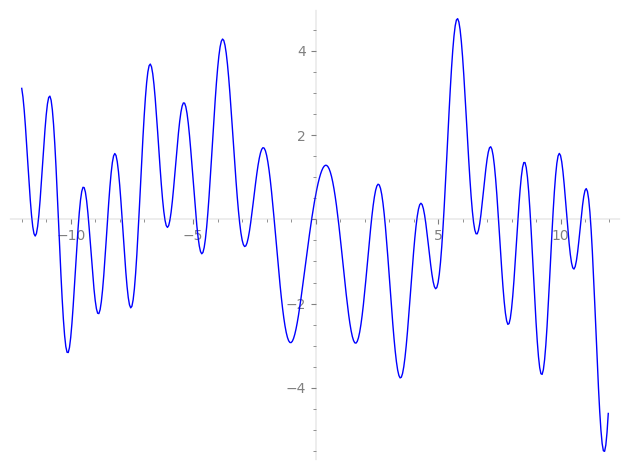| L(s) = 1 | + (−0.390 + 2.61i)7-s + (−2.17 − 1.25i)11-s − 2.11·13-s + (−3.89 − 2.24i)17-s + (−4.89 + 2.82i)19-s + (3.99 + 6.91i)23-s − 4.97i·29-s + (6.13 + 3.54i)31-s + (8.09 − 4.67i)37-s + 6.23·41-s + 9.47i·43-s + (−9.04 + 5.22i)47-s + (−6.69 − 2.04i)49-s + (3.74 − 6.48i)53-s + (−0.188 + 0.325i)59-s + ⋯ |
| L(s) = 1 | + (−0.147 + 0.989i)7-s + (−0.656 − 0.378i)11-s − 0.585·13-s + (−0.944 − 0.545i)17-s + (−1.12 + 0.648i)19-s + (0.832 + 1.44i)23-s − 0.923i·29-s + (1.10 + 0.636i)31-s + (1.33 − 0.768i)37-s + 0.973·41-s + 1.44i·43-s + (−1.31 + 0.761i)47-s + (−0.956 − 0.292i)49-s + (0.514 − 0.890i)53-s + (−0.0245 + 0.0424i)59-s + ⋯ |
\[\begin{aligned}\Lambda(s)=\mathstrut & 6300 ^{s/2} \, \Gamma_{\C}(s) \, L(s)\cr =\mathstrut & (-0.172 + 0.985i)\, \overline{\Lambda}(2-s) \end{aligned}\]
\[\begin{aligned}\Lambda(s)=\mathstrut & 6300 ^{s/2} \, \Gamma_{\C}(s+1/2) \, L(s)\cr =\mathstrut & (-0.172 + 0.985i)\, \overline{\Lambda}(1-s) \end{aligned}\]
Particular Values
| \(L(1)\) |
\(\approx\) |
\(0.5701258733\) |
| \(L(\frac12)\) |
\(\approx\) |
\(0.5701258733\) |
| \(L(\frac{3}{2})\) |
|
not available |
| \(L(1)\) |
|
not available |
\(L(s) = \displaystyle \prod_{p} F_p(p^{-s})^{-1} \)
| $p$ | $F_p(T)$ |
|---|
| bad | 2 | \( 1 \) |
| 3 | \( 1 \) |
| 5 | \( 1 \) |
| 7 | \( 1 + (0.390 - 2.61i)T \) |
| good | 11 | \( 1 + (2.17 + 1.25i)T + (5.5 + 9.52i)T^{2} \) |
| 13 | \( 1 + 2.11T + 13T^{2} \) |
| 17 | \( 1 + (3.89 + 2.24i)T + (8.5 + 14.7i)T^{2} \) |
| 19 | \( 1 + (4.89 - 2.82i)T + (9.5 - 16.4i)T^{2} \) |
| 23 | \( 1 + (-3.99 - 6.91i)T + (-11.5 + 19.9i)T^{2} \) |
| 29 | \( 1 + 4.97iT - 29T^{2} \) |
| 31 | \( 1 + (-6.13 - 3.54i)T + (15.5 + 26.8i)T^{2} \) |
| 37 | \( 1 + (-8.09 + 4.67i)T + (18.5 - 32.0i)T^{2} \) |
| 41 | \( 1 - 6.23T + 41T^{2} \) |
| 43 | \( 1 - 9.47iT - 43T^{2} \) |
| 47 | \( 1 + (9.04 - 5.22i)T + (23.5 - 40.7i)T^{2} \) |
| 53 | \( 1 + (-3.74 + 6.48i)T + (-26.5 - 45.8i)T^{2} \) |
| 59 | \( 1 + (0.188 - 0.325i)T + (-29.5 - 51.0i)T^{2} \) |
| 61 | \( 1 + (8.41 - 4.85i)T + (30.5 - 52.8i)T^{2} \) |
| 67 | \( 1 + (3.25 + 1.87i)T + (33.5 + 58.0i)T^{2} \) |
| 71 | \( 1 + 9.01iT - 71T^{2} \) |
| 73 | \( 1 + (-2.46 + 4.26i)T + (-36.5 - 63.2i)T^{2} \) |
| 79 | \( 1 + (7.97 + 13.8i)T + (-39.5 + 68.4i)T^{2} \) |
| 83 | \( 1 + 2.29iT - 83T^{2} \) |
| 89 | \( 1 + (8.85 + 15.3i)T + (-44.5 + 77.0i)T^{2} \) |
| 97 | \( 1 + 4.14T + 97T^{2} \) |
| show more | |
| show less | |
\(L(s) = \displaystyle\prod_p \ \prod_{j=1}^{2} (1 - \alpha_{j,p}\, p^{-s})^{-1}\)
Imaginary part of the first few zeros on the critical line
−7.898477825531490107231199848186, −7.22027233336999393553693138815, −6.15558907216805821270581043008, −5.94252397138708834322337362824, −4.87437720681076152412992227472, −4.42100897151749326471487094111, −3.11697999373229175163694570172, −2.63256239922046896507141491036, −1.69296619315365649434107340475, −0.16249056313386535554536986130,
0.921644978380745981134598784167, 2.28468699724608690028170635150, 2.82198763432019033472567318176, 4.13348200567514141079343960147, 4.47668266967273587160962081627, 5.22193326323844450628102355508, 6.43489043816944474366252265056, 6.72626656028076704469698462227, 7.46813633096341476915209963263, 8.262212240647071462984667258262

